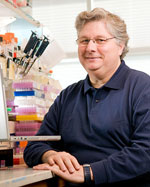Robert Weiss
Professor of Human Genetics
DNA Hybridization, DNA Sequencing

Molecular Biology Program
Education
B.S. Massachusetts Institute of Technology
Ph.D. University of Washington
Research
Research in our laboratory uses genomic approaches and technologies to understand the underlying biology of the genetic components of human disease. Projects include:
- Large-scale genomic sequencing.
- Single nucleotide discovery by resequencing human genes.
- Mutation detection in select human genes.
- Gene expression analysis in mouse models of human disease.
- Bioinformatic analysis for integrating genomic information.
Our genome sequencing projects include mammalian genomic sequencing, SNP and mutation discovery by resequencing human genes, and microbial genome sequencing. Our laboratory has been a participant in the International Sequencing Consortia that recently completed the draft sequence of the mouse and rat genomes. As we build upon the foundation laid by the Human Genome Project, it’s become clear that comparing the human genome with those of other organisms is the most powerful tool available to understand the complex genomic components involved in human health and disease
Human illness is caused by many interrelated factors including aging, inherited genetic predispositions, and a variety environmental exposures. There is increasing awareness of the role that genetics plays as a factor in disease susceptibility. In some cases, a genetic factor influences disease susceptibility in a small fraction of the population because it occurs at a low frequency or involves a relatively low incidence disease; however, in other cases, a genetic factor increases susceptibility in a large number of individuals and involves a disease that occurs at high incidence, creating a large public health burden. As the human genome sequence neared completion in the late 1990s, it became clear that a complete genome sequence would be an important tool for understanding human health and disease, but the sequence alone would be insufficient to answer many questions about the genetic basis of disease. In particular, a comprehensive database of variation in the human genome is needed, to facilitate identification and characterization of highly penetrant Mendelian disease genes and less penetrant disease susceptibility loci. Our resequencing efforts focus on the discovery and annotation of single nucleotide polymorphisms (SNPs), the most common form of human genetic variation, in candidate disease genes. These sequencing projects include identification of DNA polymorphic sites, bioinformatics-based sequence analysis, validation of DNA sequence variants, comparative genomics, analysis of alternative splicing, and studies of gene-regulatory regions. Combined with comparative and gene expression analysis in the laboratory mouse, our genomic tools are opening new routes to increase our understanding of the genetic components of human disease.
Our sequencing technology is also used in the tracking down disease-causing mutations in a variety of genetically inherited muscular dystrophies, such Duchenne muscular dystrophy. Precise knowledge of the molecular defect in these diseases will improve early detection and screening, diagnosis, and eventually treatment and prevention.
References
- Gahring LC, Persiyanov K, Dunn DM, Weiss RB, Meyer EL, Rogers SW (2004) Mouse strain-specific nicotinic acetylcholine receptor expression by inhibitory interneurons and astrocytes in the dorsal hippocampus. J Comp Neurol 468:334-46.
- Doak TG, Cavalcanti AR, Stover NA, Dunn DM, Weiss RB, Herrick G, Landweber LF (2003) Sequencing the Oxytricha trifallax macronuclear genome: a pilot project. Trends Genet 19:603-7.
- Flanigan KM, Niederhausern Av A, Dunn DM, Alder J, Mendell JR, Weiss RB (2003) Rapid direct sequence analysis of the dystrophin gene. Am J Hum Genet 72:931-9
- Padow M, Lai L, Deivanayagam C, DeLucas LJ, Weiss RB, Dunn DM, Wu X, Kappes JC (2003) Replication of chimeric human immunodeficiency virus type 1 (HIV-1) containing HIV-2 integrase (IN): naturally selected mutations in IN augment DNA synthesis. J Virol 77:11050-9.
- Dunn DM, Ishigami T, Pankow J, Von Niederhausern A, Alder J, Hunt SC, Leppert MF, Lalouel JM, Weiss RB (2002) Common variant of human NEDD4L activates a cryptic splice site to form a frameshifted transcript. J Hum Genet 47:665-76
- Bamshad MJ, Mummidi S, Gonzalez E, Ahuja SS, Dunn DM, Watkins WS, Wooding S, Stone AC, Jorde LB, Weiss RB, Ahuja SK (2002) A strong signature of balancing selection in the 5′ cis-regulatory region of CCR5. Proc Natl Acad Sci U S A 99:10539-44
- Waterston RH, Lindblad-Toh K, Birney E, Rogers J, Abril JF, Agarwal P, Agarwala R, et al. (2002) Initial sequencing and comparative analysis of the mouse genome. Nature 420:520-562
- Wooding SP, Watkins WS, Bamshad MJ, Dunn DM, Weiss RB, Jorde LB (2002) DNA Sequence Variation in a 3.7-kb Noncoding Sequence 5′ of the CYP1A2 Gene: Implications for Human Population History and Natural Selection. Am J Hum Genet 71:528-42
- Robb FT, Maeder DL, Brown JR, DiRuggiero J, Stump MD, Yeh RK, Weiss RB, Dunn DM (2001) Genomic sequence of hyperthermophile, Pyrococcus furiosus: implications for physiology and enzymology. Methods Enzymol 330:134-57.
- Diruggiero J, Dunn D, Maeder DL, Holley-Shanks R, Chatard J, Horlacher R, Robb FT, Boos W, Weiss RB (2000) Evidence of recent lateral gene transfer among hyperthermophilic archaea. Mol Microbiol 38:684-93.
